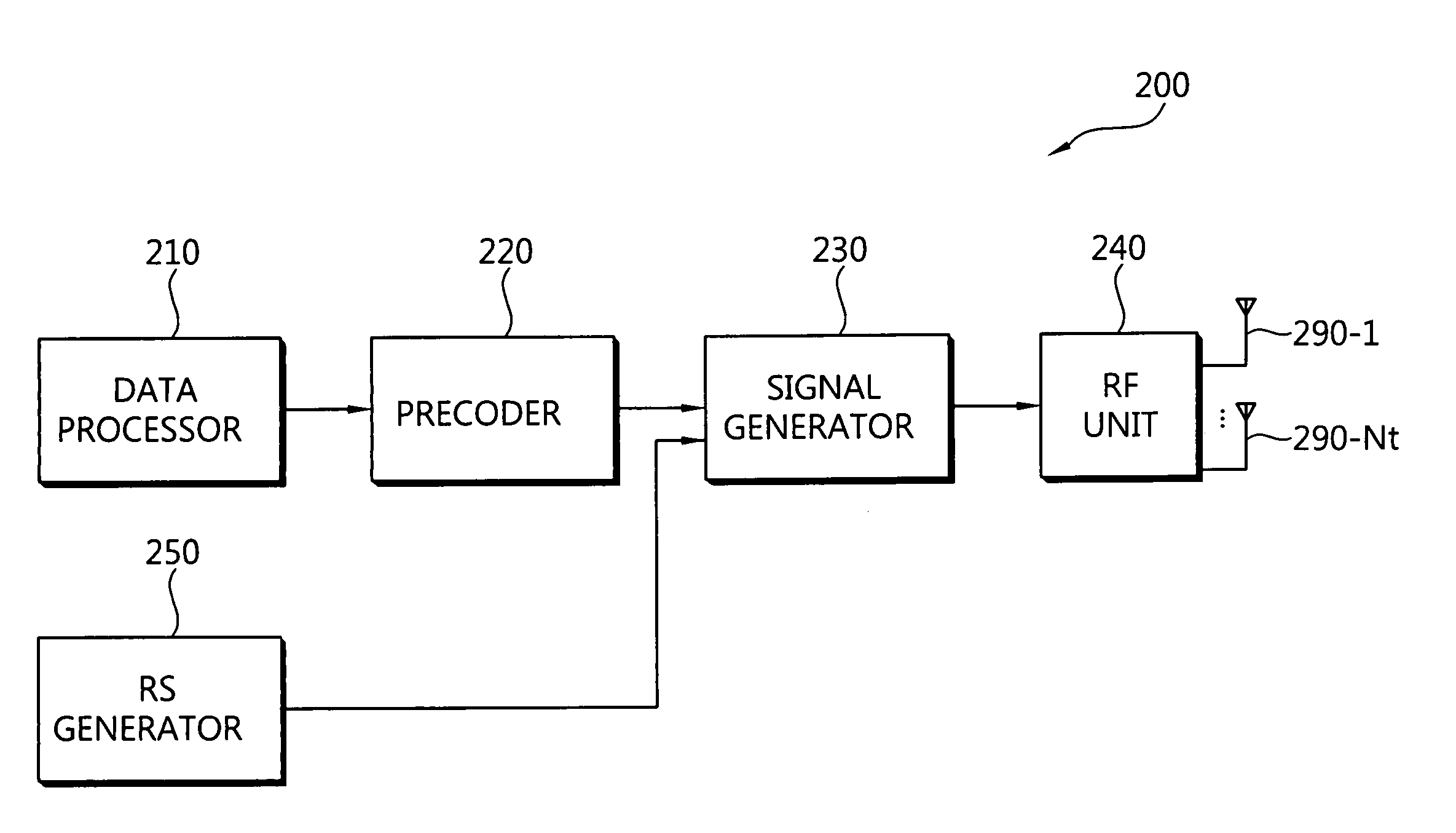Method and apparatus of transmitting reference signal for uplink transmission
a reference signal and transmission method technology, applied in wireless communication, multi-component communication, assessment restriction, etc., to achieve the effect of improving the overall performance of a wireless communication system and increasing the efficiency of uplink transmission
- Summary
- Abstract
- Description
- Claims
- Application Information
AI Technical Summary
Benefits of technology
Problems solved by technology
Method used
Image
Examples
first embodiment
II-1. First Embodiment
[0112]If multiple data streams are transmitted on PUSCH, each transmit antenna requires a RS. Accordingly, multiple RSs must be allocated to a single UE. Allocation of as many RSs as the number of transmit antennas irrespective of a rank can be considered as a RS allocation method. As many non-precoded RSs as the number of transmit antennas are allocated to each UE. For example, if a ZC sequence is used as a RS sequence, two cyclic shift values of the ZC sequence may be allocated to a UE using two transmit antennas for RSs. A BS may generate a precoded channel by using non-precoded RSs and information on precoding. Here, the BS needs to know precoding information (for example, precoding matrix, precoding vector, CCD cyclic delay value, etc.). The precoding information may be previously determined, defined such that the precoding information is changed according to a determined rule or allocated by the BS to a UE through an RRC (Radio Resource Control) message o...
second embodiment
II-2. Second Embodiment
[0116]A single precoded RS is used if a rank is 1 and a plurality of non-precoded RSs that are identified using different cyclic shifts are used if the rank is greater than 1. As described above, a precoded RS may cause an increase in PAPR when two or more streams are transmitted, and thus the precoded RS is used only for transmission of a single data stream to maintain the advantage of SC-FDMA and apply boosting power of the RS.
[0117]If a UE uses transmit diversity based on SU-MIMO or CDD which has a rank of 1, a single precoded RS is allocated. A BS can directly obtain a precoded channel from the precoded RS.
[0118]When SU-MIMO or block-STBC having a rank higher than 1 is used, multiple non-precoded RSs are allocated to the UE because PAPR may increase if a precoded RS is used. The BS can obtain a channel by using the non-precoded RSs and precoding information. The various methods described in clause II-1 can be used to allocate multiple RSs.
[0119]In SC-FDMA ...
third embodiment
II-3. Third Embodiment
[0125]In transmit diversity based on SU-MIMI or CDD having a rank of 1, a single precoded RS is used. A BS can directly obtain a channel through the precoded RS.
[0126]When SU-MIMI or block-STBC having a rank greater than 1 is used, a plurality of non-precoded RSs are used. A RS for SU-MIMP having a rank greater than 1 is not precoded because low PAPR is maintained and power boosting of the RS is obtained. Here, a plurality of time domain symbols (for example, OFDMA symbols) are allocated as RSs. In this case, a single cyclic shift may be allocated, which is distinguished from the second embodiment. RSs for respective streams (or layers) can be identified according to time domain orthogonalization or both the time domain orthogonalization and code domain orthogonalization. The code domain orthogonalization can be obtained according to orthogonal covering, that is, different cyclic shifts, Walsh code, DFT matrix and a combination thereof.
[0127]FIG. 15 illustrates...
PUM
 Login to View More
Login to View More Abstract
Description
Claims
Application Information
 Login to View More
Login to View More - R&D
- Intellectual Property
- Life Sciences
- Materials
- Tech Scout
- Unparalleled Data Quality
- Higher Quality Content
- 60% Fewer Hallucinations
Browse by: Latest US Patents, China's latest patents, Technical Efficacy Thesaurus, Application Domain, Technology Topic, Popular Technical Reports.
© 2025 PatSnap. All rights reserved.Legal|Privacy policy|Modern Slavery Act Transparency Statement|Sitemap|About US| Contact US: help@patsnap.com



